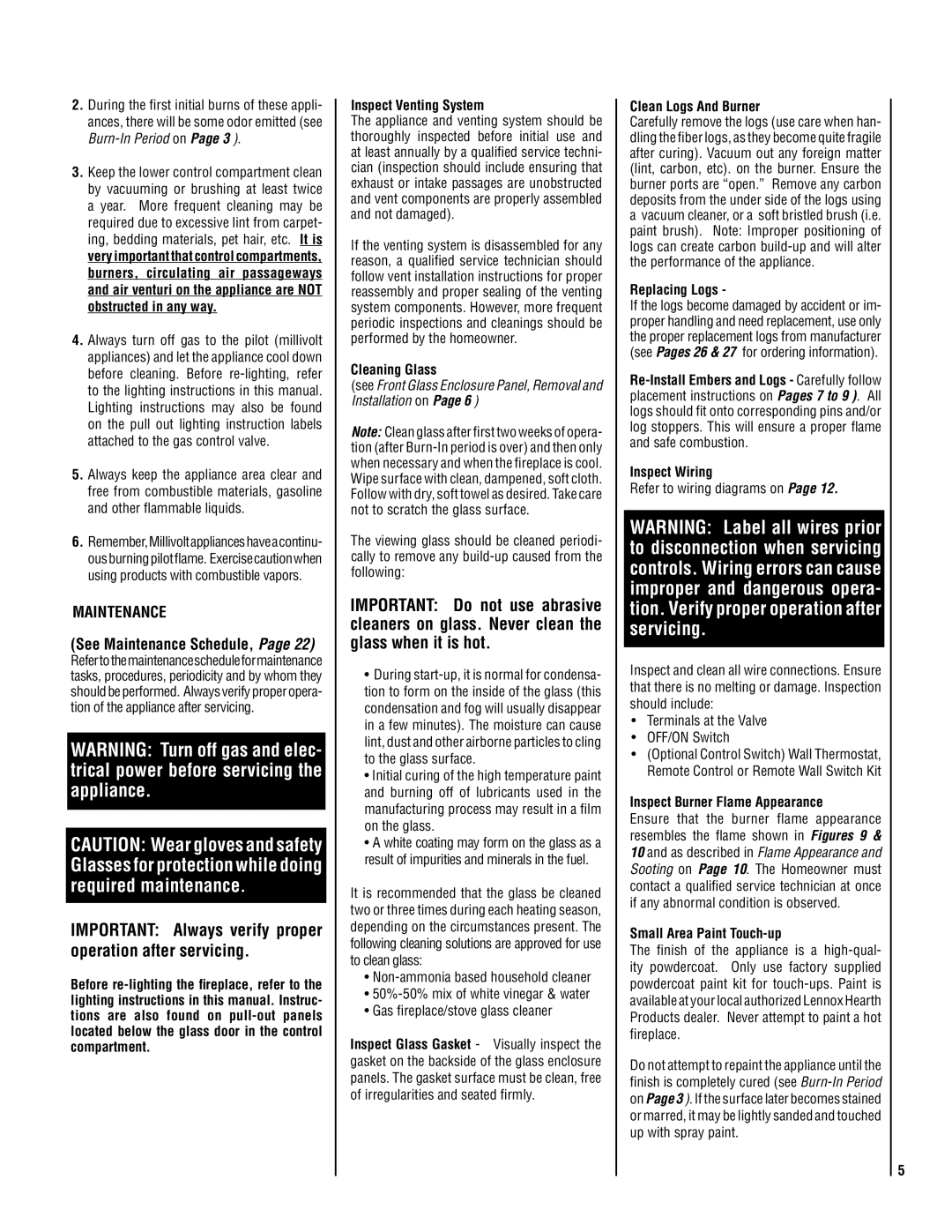
2.During the first initial burns of these appli- ances, there will be some odor emitted (see
3.Keep the lower control compartment clean by vacuuming or brushing at least twice a year. More frequent cleaning may be required due to excessive lint from carpet- ing, bedding materials, pet hair, etc. It is very important that control compartments, burners, circulating air passageways and air venturi on the appliance are NOT obstructed in any way.
4.Always turn off gas to the pilot (millivolt appliances) and let the appliance cool down before cleaning. Before
5.Always keep the appliance area clear and free from combustible materials, gasoline and other flammable liquids.
6.Remember,Millivoltapplianceshaveacontinu- ousburningpilotflame. Exercisecautionwhen using products with combustible vapors.
MAINTENANCE
(See Maintenance Schedule, Page 22)
Refertothemaintenancescheduleformaintenance tasks, procedures, periodicity and by whom they should be performed. Always verify proper opera- tion of the appliance after servicing.
WARNING: Turn off gas and elec- trical power before servicing the appliance.
CAUTION: Wear gloves and safety Glasses for protection while doing required maintenance.
IMPORTANT: Always verify proper operation after servicing.
Before
Inspect Venting System
The appliance and venting system should be thoroughly inspected before initial use and at least annually by a qualified service techni- cian (inspection should include ensuring that exhaust or intake passages are unobstructed and vent components are properly assembled and not damaged).
If the venting system is disassembled for any reason, a qualified service technician should follow vent installation instructions for proper reassembly and proper sealing of the venting system components. However, more frequent periodic inspections and cleanings should be performed by the homeowner.
Cleaning Glass
(see Front Glass Enclosure Panel, Removal and Installation on Page 6 )
Note: Clean glass after first two weeks of opera- tion (after
The viewing glass should be cleaned periodi- cally to remove any
IMPORTANT: Do not use abrasive cleaners on glass. Never clean the glass when it is hot.
•During
•Initial curing of the high temperature paint and burning off of lubricants used in the manufacturing process may result in a film on the glass.
•A white coating may form on the glass as a result of impurities and minerals in the fuel.
It is recommended that the glass be cleaned two or three times during each heating season, depending on the circumstances present. The following cleaning solutions are approved for use to clean glass:
•
•
•Gas fireplace/stove glass cleaner
Inspect Glass Gasket - Visually inspect the gasket on the backside of the glass enclosure panels. The gasket surface must be clean, free of irregularities and seated firmly.
Clean Logs And Burner
Carefully remove the logs (use care when han- dling the fiber logs, as they become quite fragile after curing). Vacuum out any foreign matter (lint, carbon, etc). on the burner. Ensure the burner ports are “open.” Remove any carbon deposits from the under side of the logs using
avacuum cleaner, or a soft bristled brush (i.e. paint brush). Note: Improper positioning of logs can create carbon
Replacing Logs -
If the logs become damaged by accident or im- proper handling and need replacement, use only the proper replacement logs from manufacturer (see Pages 26 & 27 for ordering information).
Inspect Wiring
Refer to wiring diagrams on Page 12.
WARNING: Label all wires prior to disconnection when servicing controls. Wiring errors can cause improper and dangerous opera- tion. Verify proper operation after servicing.
Inspect and clean all wire connections. Ensure that there is no melting or damage. Inspection should include:
•Terminals at the Valve
•OFF/ON Switch
•(Optional Control Switch) Wall Thermostat, Remote Control or Remote Wall Switch Kit
Inspect Burner Flame Appearance
Ensure that the burner flame appearance resembles the flame shown in Figures 9 & 10 and as described in Flame Appearance and Sooting on Page 10. The Homeowner must contact a qualified service technician at once if any abnormal condition is observed.
Small Area Paint Touch-up
The finish of the appliance is a
Do not attempt to repaint the appliance until the finish is completely cured (see
